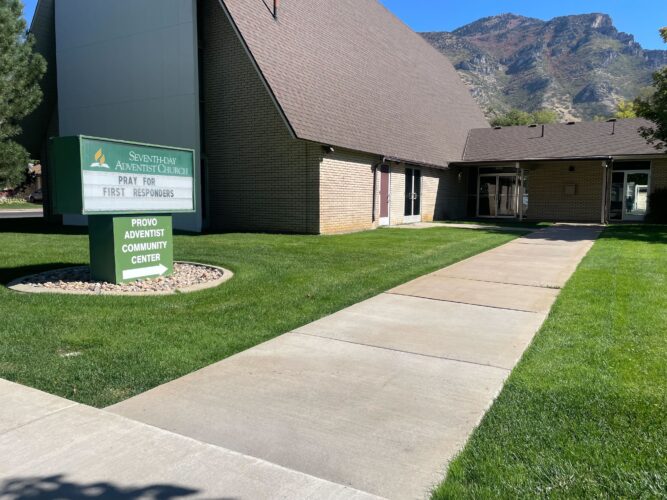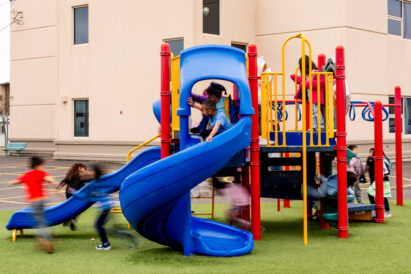Homeless advocates issue call for volunteers to staff Utah County warming centers as launch date looms

Curtis Booker, Daily Herald
This photo taken Friday, Oct. 4, 2024, shows the outside of Provo Seventh-day Adventist Church, one of the three sites set to serve as warming centers for the 2024-2025 winter season.Utahns have been known for their happy-to-help spirit.
In early 2023, Utah was nationally recognized for being the No. 1 state in the country for volunteer service.
Citizens eager to donate their time and give back to the communities they represent will have dozens of opportunities to do so beginning later this month.
For nearly 200 nights, three facilities in Utah County will rotate as warming centers to keep the unhoused off the streets this fall and winter.
In August, the Utah County Winter Response Task Force announced that Genesis Project Provo, Provo Seventh-day Adventist Church and the Utah County Red Building will operate as warming centers on a rotating schedule.
The program will run for just over six months beginning Oct. 15 through April 30, 2025, accommodating up to 75 people each night.
As the launch date nears, there’s a strong call for volunteers to help with staffing during operating hours.
“We have several volunteer shifts available every night,” said Heather Hogue, director of the Mountainland Continuum of Care. “We’ll have paid stuff on (hand) but that’s got to be supplemented by volunteers throughout the night.”
The 2024-25 winter response plan is an extension of last year’s pilot program.
In April, homeless advocates told the Daily Herald that while the previous year’s efforts were a success, they stressed the likelihood of a need for more staffing this winter.
Hogue said a minimum of six volunteers are needed per night to help staff the warming centers.
Paid staff will be onsite during warming center hours to supervise and collect data to further understand the scope of homelessness in the county.
“Our volunteers are there to get to know the people that are experiencing homelessness, to help with meeting some of those basic needs, to help make sure that people are safe and secure through the night,” Hogue said.
Another role of the volunteers is to help humanize the vulnerable citizens who utilize the centers by creating a one-on-one connection with them.
“You know, that interaction with a group in our community that is so often marginalized is so critical,” Hogue said. “Both for our marginalized community to feel included, but also for us to understand that we’re all human, we’re all people, we’re all the same. And so that’s one of the reasons that this volunteer effort, for me, feels so critical.”
Because of the diverse range of people who will use the warming centers, volunteers will be briefed on how to handle a variety of situations that may arise.
Hogue noted that there’s always a possibility someone experiencing life trauma and in crisis may have an episode that requires experienced social workers and staff who can work to deescalate an issue.
“We did not encounter very much of that last year, but one of the things that I tell people is (if) you’ve got 40 people staying in the warming center, (and) you’ve got one person in crisis, you don’t just have a paid staff and two volunteers … you’ve also got 39 individuals experiencing homelessness who are invested in helping out their friend in crisis,” Hogue explained.
Over the next six months while the Utah County Winter Response plan is in place, advocates plan to work toward learning the origins of what led people using the warming centers into homelessness and identify gaps in critically needed resources.
“We’re going to learn a lot about where people are coming from in our community. We’re going to learn a lot about if they’re enrolled in services. We’re going to kind of see where our gaps are as far as finding people in our community that are vulnerable,” Hogue told the Daily Herald.
She’s laid out a couple of objectives that will be the focus of the warming each night over the course of the winter: ensuring people stay alive and connecting them with existing wraparound services.
“So every interaction (at) that warming center will be with a mindset of getting people into lasting services that are really going to address the barriers that led to homelessness,” Hogue said.
She classified this summer, in the months leading up to October, as productive in planning and coordinating efforts to make the warming centers successful.
She also expressed gratitude to the partnering service agencies, cities and state leaders who have all worked together in getting the response effort off the ground.
“The county has been proactive in addressing homelessness, providing a wide range of services for many years. This initiative is a significant and positive addition to those efforts,” said Wayne Niederhauser, Utah state homeless coordinator and task force member, in a press release from August.
Aside from volunteers, blankets, water bottles, snacks and other items are being accepted for those who want to donate. A full list can be found at mountainlandcoc.org.
Warming center hours will be 9 a.m. to 8 a.m.
Volunteers must be at least 18 years old. Those wishing to serve can sign up for shifts at app.vomo.org.



